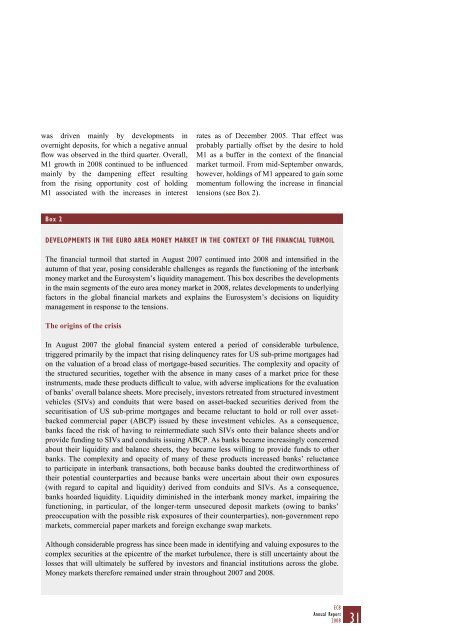ANNUAL REPORT 2008 - Polymer Bank Notes of the World
ANNUAL REPORT 2008 - Polymer Bank Notes of the World
ANNUAL REPORT 2008 - Polymer Bank Notes of the World
You also want an ePaper? Increase the reach of your titles
YUMPU automatically turns print PDFs into web optimized ePapers that Google loves.
was driven mainly by developments inovernight deposits, for which a negative annualflow was observed in <strong>the</strong> third quarter. Overall,M1 growth in <strong>2008</strong> continued to be influencedmainly by <strong>the</strong> dampening effect resultingfrom <strong>the</strong> rising opportunity cost <strong>of</strong> holdingM1 associated with <strong>the</strong> increases in interestrates as <strong>of</strong> December 2005. That effect wasprobably partially <strong>of</strong>fset by <strong>the</strong> desire to holdM1 as a buffer in <strong>the</strong> context <strong>of</strong> <strong>the</strong> financialmarket turmoil. From mid-September onwards,however, holdings <strong>of</strong> M1 appeared to gain somemomentum following <strong>the</strong> increase in financialtensions (see Box 2).Box 2DEVELOPMENTS IN THE EURO AREA MONEY MARKET IN THE CONTEXT OF THE FINANCIAL TURMOILThe financial turmoil that started in August 2007 continued into <strong>2008</strong> and intensified in <strong>the</strong>autumn <strong>of</strong> that year, posing considerable challenges as regards <strong>the</strong> functioning <strong>of</strong> <strong>the</strong> interbankmoney market and <strong>the</strong> Eurosystem’s liquidity management. This box describes <strong>the</strong> developmentsin <strong>the</strong> main segments <strong>of</strong> <strong>the</strong> euro area money market in <strong>2008</strong>, relates developments to underlyingfactors in <strong>the</strong> global financial markets and explains <strong>the</strong> Eurosystem’s decisions on liquiditymanagement in response to <strong>the</strong> tensions.The origins <strong>of</strong> <strong>the</strong> crisisIn August 2007 <strong>the</strong> global financial system entered a period <strong>of</strong> considerable turbulence,triggered primarily by <strong>the</strong> impact that rising delinquency rates for US sub-prime mortgages hadon <strong>the</strong> valuation <strong>of</strong> a broad class <strong>of</strong> mortgage-based securities. The complexity and opacity <strong>of</strong><strong>the</strong> structured securities, toge<strong>the</strong>r with <strong>the</strong> absence in many cases <strong>of</strong> a market price for <strong>the</strong>seinstruments, made <strong>the</strong>se products difficult to value, with adverse implications for <strong>the</strong> evaluation<strong>of</strong> banks’ overall balance sheets. More precisely, investors retreated from structured investmentvehicles (SIVs) and conduits that were based on asset-backed securities derived from <strong>the</strong>securitisation <strong>of</strong> US sub-prime mortgages and became reluctant to hold or roll over assetbackedcommercial paper (ABCP) issued by <strong>the</strong>se investment vehicles. As a consequence,banks faced <strong>the</strong> risk <strong>of</strong> having to reintermediate such SIVs onto <strong>the</strong>ir balance sheets and/orprovide funding to SIVs and conduits issuing ABCP. As banks became increasingly concernedabout <strong>the</strong>ir liquidity and balance sheets, <strong>the</strong>y became less willing to provide funds to o<strong>the</strong>rbanks. The complexity and opacity <strong>of</strong> many <strong>of</strong> <strong>the</strong>se products increased banks’ reluctanceto participate in interbank transactions, both because banks doubted <strong>the</strong> creditworthiness <strong>of</strong><strong>the</strong>ir potential counterparties and because banks were uncertain about <strong>the</strong>ir own exposures(with regard to capital and liquidity) derived from conduits and SIVs. As a consequence,banks hoarded liquidity. Liquidity diminished in <strong>the</strong> interbank money market, impairing <strong>the</strong>functioning, in particular, <strong>of</strong> <strong>the</strong> longer-term unsecured deposit markets (owing to banks’preoccupation with <strong>the</strong> possible risk exposures <strong>of</strong> <strong>the</strong>ir counterparties), non-government repomarkets, commercial paper markets and foreign exchange swap markets.Although considerable progress has since been made in identifying and valuing exposures to <strong>the</strong>complex securities at <strong>the</strong> epicentre <strong>of</strong> <strong>the</strong> market turbulence, <strong>the</strong>re is still uncertainty about <strong>the</strong>losses that will ultimately be suffered by investors and financial institutions across <strong>the</strong> globe.Money markets <strong>the</strong>refore remained under strain throughout 2007 and <strong>2008</strong>.ECBAnnual Report<strong>2008</strong>31




![KNOW YOUR NEW GIBRALTAR BANKNOTES - [Home] bThe/b](https://img.yumpu.com/50890985/1/184x260/know-your-new-gibraltar-banknotes-home-bthe-b.jpg?quality=85)
![PAPUA NEW GUINEA - [Home] - Polymer Bank Notes of the World](https://img.yumpu.com/49758743/1/190x143/papua-new-guinea-home-polymer-bank-notes-of-the-world.jpg?quality=85)










